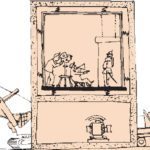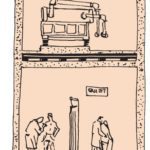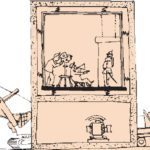Concrete Floating Floors
Concrete floating floors are used for many purposes. We have limited this bulletin to the following areas of Vibration, Sound and Impact Isolation.

1. VIBRATION ISOLATION
Buildings are unavoidably near busy streets, trains and subways even though they contain space that must be vibration free and have very low NC levels. Examples include television studios and theatres and in some cases sound test rooms located in the center of factories.
The frequency of the isolator supporting these floors is normally determined by the architect or an acoustical consultant depending on the input frequencies. Within our range of experience we recommend LDS mountings with a dynamic frequency not exceeding 10 Hz for input no lower than 20 Hz providing frequencies below 30 Hz are limited in amplitude. Steel spring isolators come into their own when the input is more severe or below 20 Hz. The required deflection of the springs is dependent on the input frequency, but most spring floating floor work is done with deflections between 0.5” and 0.75” to provide frequencies in the 4.5 to 3.6 Hz range. When heavy impact is a major factor, springs are always required.
We have provided LDS isolators to reduce subway vibration at grade. They were very effective as the lowest input frequency was measured at 20 Hz and the ground amplitudes were small. In another application, however, television studios were located on the third floor of an old building. Spring mountings were specified by the same acoustical consultant as the upper floor amplitudes were high and frequencies low, not only because of motor truck traffic outside the building, but the passage of heavy scenery wagons in halls between studios.

2. SOUND ISOLATION
Typical of these applications are the introduction of floating floors in very noisy equipment rooms located over prime office space or floating roofs as a protection against aircraft noises.
Since we are dealing with the prevention of airborne noise transmission only, LDS mountings are always the choice. The lowest audible frequency is about 25 Hz so there is no need for mountings of greater deflection. Spring mountings manufactured with LDS materials in series with the springs would work equally well in this application, but they are needlessly expensive. Since the floating floor’s frequency is too high to isolate machinery, the only function is the prevention of airborne sound transmission. Machinery supported on the floating floor must have steel or air spring isolators.

3. IMPACT ISOLATION
Examples of straight impact isolation would normally include kitchens, weight rooms or bowling alleys. A commercial kitchen in an office building generates structurally transmitted noise. The noise level within the kitchen itself might not be very high, but the rolling of carts, the dropping of dishes, the rattling of cutlery on steel tables, the placing of pots on stoves, etc., all represent impact and mechanically transmitted sound. LDS isolators have been effective in most of these applications but springs are better.
Where gym floors are the problem and we must deal with running, jumping and bouncing balls, LDS would be effective over a very rigid substructure, but once again springs are the safer approach.
JACK-UP (Lift-Slab) SYSTEM
We believe that the most fool-proof and safest way to establish the air gap is the jack-up or lift-slab method. Plastic sheeting is placed on the sub-floor as a breaker layer, isolators are placed on the plastic sheeting, reinforcing steel or mesh rests on the isolator housings, and the concrete floor is poured. After the concrete has cured, the slab is lifted to elevation by turning adjustment bolts above each isolator to any specified air gap between 1” and 4”.
FORM-WORK SYSTEM
The alternate, almost obsolete, method is one whereby a continuous layer of the isolation media is used as a pouring surface. More commonly, individual isolators, the thickness of the air gap are placed in position in the field and covered with plywood or factory attached to plywood before delivery. The upper surface is covered with a plastic layer and then the reinforcing is placed on top of the plywood forms and the concrete poured at finished elevation.
MACHINERY SUPPORT
In our older publications we advocated the support of heavy machinery on full sized structurally supported pedestals or individual structurally supported pedestals as shown in the illustrations on page 5. While the performance of systems installed that way was excellent, it proved to be a major coordination problem because the pedestals had to be located, poured and anchored to the sub-floor before the system could go ahead. There was very little saving in cost as we provided isolators around the edges of these pedestals so there was no saving in the number of isolators. There was the additional labor of installing perimeter board and caulking. We gradually modified our approach to using this method for only the heaviest of machinery such as chillers, but based on our continued experience we are now suggesting continuous floating floors with all the housekeeping pads and equipment on top.

JACK-UP VERSUS FORM-WORK METHOD
When the form-work method is used, the spacing of the mountings is a function of the stiffness of the forms which support the wet concrete. In using half inch plywood, which is the most common form, we have tested 12”, 16” and 24” spacing. We have found 24” spacing to be highly satisfactory. Closer spacing merely means more fussing with light capacity mountings and in comparing 12” with 24” spacing the introduction of four times as many transmission points.
Our development of the lift-slab method accelerated in 1962 when we isolated some 30,000 square feet of television studios for CBS using jack-up spring mountings. The mountings were designed to the performance specifications of an acoustical consultant. This new method was an immediate success.
When using the lift-slab technique, the spacing of the isolators is determined by the thickness of the floating floor and the reinforcement. When 4” slabs are used, a spacing of 54” in both directions is well within design limitations. Thus we have 1/20 the number of transmission pads offered by a form work or panel system using 12” spacing. Thicker slabs allow for wider spacing and 60” or more is not unusual.
